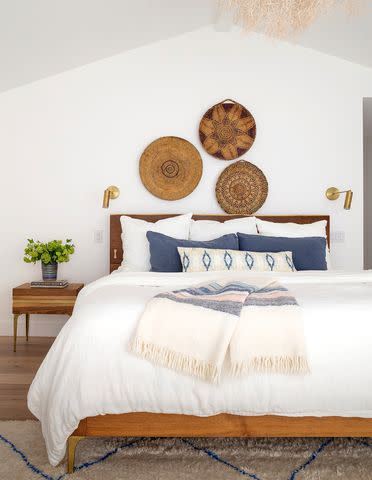How to Transition Your Bedding for the Season Ahead
And why you really should.

Better Homes & Gardens / David Tsay
Changing your bedding for the season isn’t a requirement, but it does have benefits if you’re inclined to make the swap. The first thing to know is that you don’t necessarily need to change your bedding four times a year. To update seasonally, take a twice-yearly approach (think: spring/summer and fall/winter). Or if you just want to get extra cozy during the winter, consider placing a faux fur or chunky knit throw at the bottom of the bed and you’re good to go from October through February (give or take, depending on your location).
So what exactly are the benefits of swapping your linens for the season? The first and most obvious reason to change bedding when the weather starts to cool down is for warmth. A heavier duvet (such as this Better Homes & Gardens Tonal Matelasse Blue Cove Duvet Cover, $50, Walmart) or comforter or even a heavier cover can keep you perfectly warm and toasty all season long. Throw blankets, coverlets, and quilts also provide beneficial layering that allows for more customized temperature control.
And when it comes to aesthetics, the arrival of cold weather is also an excuse to redecorate. Autumnal hues? Luxurious fabrics? All the cozy comfort? Yes, please. Swapping your bedding for the season will help you be more comfortable as you sleep and create a fresh look for the changing weather.

Better Homes & Gardens / Edmund Barr
The Best Bedding for Fall
If you’re a warm sleeper, you might want to stick with the more breathable fabrics like bamboo and cotton for your sheets, even through the winter. From there, add layers of different fabric materials to bring a warm, textural look. These are the most common fabric types for bedding—from sheets to duvets.
Bamboo: Bamboo is a good alternative to cotton, providing both breathability and durability—two essentials for warm sleepers. Bamboo sheets are also a favorite of those looking to make more eco-conscious selections. Just beware of varieties that require chemical processes for manufacturing.
Cotton: If your top considerations are affordability and easy care, turn to layers of cotton bedding (like this Better Homes & Gardens Gray Aztec Stripe Cotton Quilt, $55, Walmart). Choose from a variety of weaves: twill, percale, sateen, and jersey. Cotton gets bonus points for softening as it ages, but it is especially lauded for its year-round appeal and popularity (meaning there are plenty of color and style choices to choose from). This makes it an ideal choice for that first bedding layer.
Flannel: Flannel sheets provided added warmth in cool climates. Just know that you might overheat if you tend to sleep warm. Choose the weight of your flannel sheets according to both your room’s temperature and your body temperature as you sleep.
Velvet: Velvet makes a pretty, elegant choice, particularly for quilts. This opulent fabric also comes with lots of warmth.
Related: The 10 Best Organic Sheets for a Dreamy Bedroom

Better Homes & Gardens / Edmund Barr
Choosing the Right Layers
Whether outerwear or bed linens, layering during the fall is important. If it’s a particularly chilly night, you’ll want all the warmth that cozy fabrics can give. Plus, you can easily peel them off one by one as needed to drift off to sleep in cool comfort. These are the essential layers for a fall bed.
Sheets: Use both a top sheet and a fitted sheet in the fall—even if you’re tempted to skip the flat sheet. It’s particularly important to pay attention to your fabric composition when it comes to the layers closest to your body. Select an option that is both breathable and soft. If you aren’t prone to getting warm while you sleep, consider a heavier option like flannel.
Quilt or Coverlet: No matter which option you opt for, this layer can provide more warmth than a blanket, but it’s likely too thin to be the outermost layer during the chillier seasons. Place a comfy quilt or coverlet just under a duvet, pulling the top of your flat sheet over the edge of the quilt for a crisp, finished look.
Comforter or Duvet: Your comforter or duvet packs warmth and provides the weight you need to sleep comfortably. Take into consideration how warm or cold you sleep, your climate, and the temperature of your room at night to determine the level of insulation that’s best suited for your ideal sleeping conditions. Also, keep in mind the weight of the cover you’ll place over your duvet as that will add an additional layer of heat retention.
Related: How to Put on a Duvet Cover with Ease
Bed Blanket: A bed blanket is a lightweight option for adding additional warmth over a quilt, coverlet, duvet, or comforter. Alternatively, you can layer it below the outer bedding, placing it atop the sheets and tucking it in the same way. Bed blankets are much larger than throws, with dimensions that coordinate with standard mattress sizes, and they come in a wide range of fabric options and weights.
Throw: Use a throw blanket for even more warmth or just a little added visual interest. Pay attention to texture as this can be a great place to add some for a more elevated bedding look.
Pillows: Don’t underestimate pillows—especially during the nesting months. You can certainly add one or two more than your spring/summer display, but be careful not to go overboard. For a king-size bed, two standard pillows, two sham pillows, and a few throw pillows or a bolster pillow will create a finished (but not overdone) look.
For more Better Homes & Gardens news, make sure to sign up for our newsletter!
Read the original article on Better Homes & Gardens.

